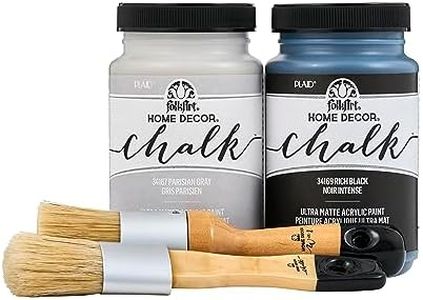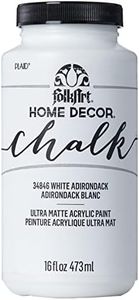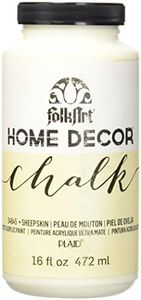We Use CookiesWe use cookies to enhance the security, performance,
functionality and for analytical and promotional activities. By continuing to browse this site you
are agreeing to our privacy policy
10 Best Chalk Paints
From leading brands and best sellers available on the web.By clicking on a link to a third party's website, log data is shared with that third party.
Buying Guide for the Best Chalk Paints
Choosing the best chalk paint for your project can really impact the look, durability, and ease of use of your finished piece. Chalk paints have become popular for their matte finish, ease of application, and vintage look they give to furniture, walls, or crafts. When shopping, take some time to consider what you want your final result to look like, where and how the item will be used, and your own level of experience. Comparing the right features will help you select a chalk paint that matches your needs, whether you’re flipping furniture, decorating a nursery, or adding accents to crafts.FinishThe finish of a chalk paint refers to the look and feel of the surface after the paint is dry. Chalk paint is most famous for its matte, velvety finish, but some formulas may be slightly more satin or lustrous. This is important because the finish affects both appearance and how well the paint hides surface imperfections. For a traditional, rustic or vintage look, a soft matte finish is best. A more satin finish can offer slightly more durability and is easier to wipe clean. Think about what kind of vibe you want for your piece and where it will be placed when deciding—if you love old-school charm, matte is great, but for busy areas, you may want something with a touch more sheen.
CoverageCoverage tells you how much area a can of chalk paint will cover, and how many coats you’ll need for a solid finish. Good coverage means less paint and work are needed, while poor coverage often requires multiple coats. Coverage can range from highly pigmented paints that give you strong color in a single coat, to thinner options that need two or three coats for full opacity. If you want to finish quickly or are working on large pieces, higher coverage is more convenient. For detailed or layered looks (like distressing), slightly less coverage can actually help create your effects more easily.
ApplicationApplication refers to how easy it is to spread and control the chalk paint. Some paints are thicker and creamy, making them less likely to drip but a bit harder to spread smoothly, while thinner paints flow more easily but might run. Ease of application also involves how well the paint sticks to surfaces without sanding or priming. If you’re a beginner, or tackling intricate furniture, a paint that is easy to brush on and forgiving with brush strokes will make your project less frustrating. If you’re experienced or want to try special finishes, a thicker paint might be desirable for more texture.
Drying TimeDrying time is how long the chalk paint takes to set before you can handle it or apply another coat. Some chalk paints dry within 30 minutes, while others may take a few hours. Quick-drying paints are great when you want to complete a project in a single day, but may give you less time to work on blending or effects. If you prefer to work slowly or are layering colors and textures, a slightly longer drying time might actually be helpful.
Surface CompatibilityChalk paints can be used on many surfaces—wood, metal, glass, laminate, fabric, and more. Some formulas perform better on slick or glossy surfaces without much prep work, while others might require sanding or priming for the best results. Think about what you’ll paint most often. If you’re refinishing wooden furniture, almost any chalk paint will do. For painting glass jars, metal frames, or laminated cabinets, look for options that specifically mention strong adhesion to non-porous surfaces.
VOC and OdorVOC stands for Volatile Organic Compounds, which are chemicals that can evaporate into the air and cause odors or health concerns. Chalk paints are generally low in VOCs, but some are even safer with ultra-low or zero VOC levels and minimal odor. This is especially important if you’re painting indoors, in poorly ventilated areas, or around children or pets. For sensitive users or indoor projects, look for paints labeled low- or no-VOC.
Color SelectionChalk paints come in a range of colors, but some brands offer only a few standard, muted shades, while others have a large variety. Classic chalk paints focus on whites, greys, and pastels, perfect for vintage looks. If you have a bold, specific palette in mind, you may want to seek out lines with more modern or vibrant color options. Think about whether you want something timeless and neutral or something that fits a unique decor scheme.
Durability and Finish ProtectionChalk paint itself usually has a soft, powdery finish that can be prone to scratches or marks, so it often needs a topcoat or sealer like wax or polycrylic for durability. Some chalk paints come with added durability in the formula, while others must be protected with an extra step. For high-traffic surfaces like dining tables or cabinets, you’ll want to factor in how easy it is to protect the finish and whether the paint itself is tough enough for your needs.

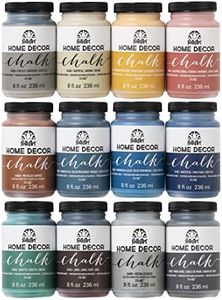
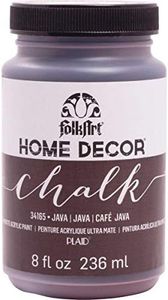
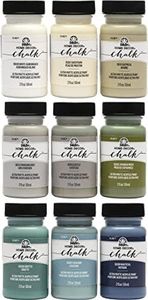


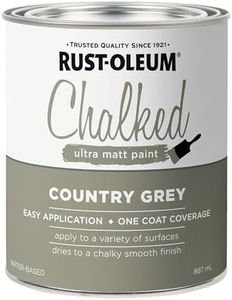
![Chalk Style Paint - for Furniture, Home Decor, Crafts - Eco-Friendly - All-in-One - No Wax Needed (Liquorice [Black], Sample (4 oz))](https://images-proxy.bestreviews.guide/gvrv_0h6Mw8HHqGKuxuo29AAHhw=/0x300/https://m.media-amazon.com/images/I/415byj-n6nL._AC_CX679_.jpg)
